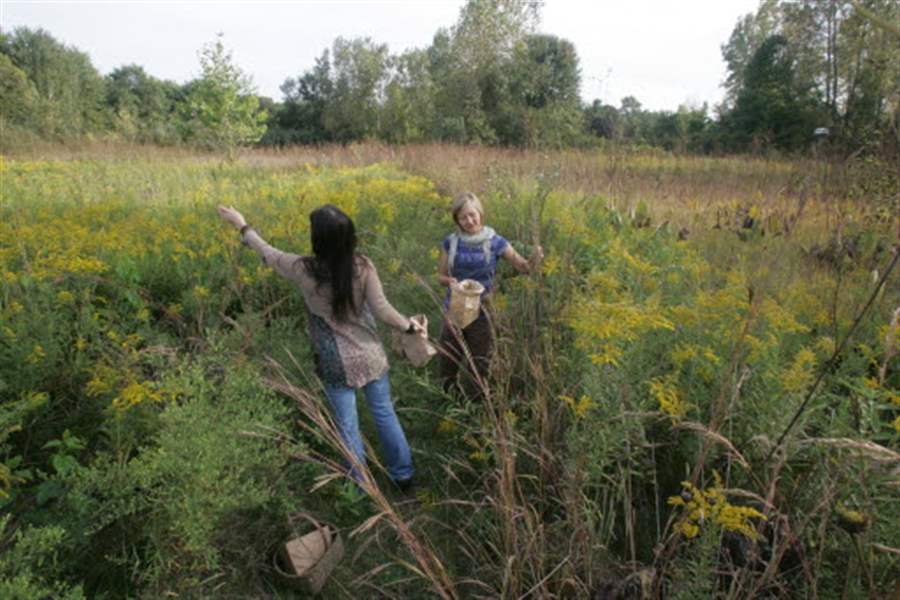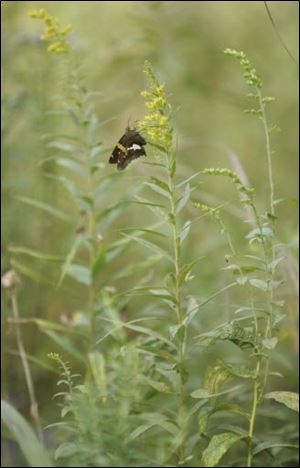
Prairie companion: Woman transforms field into a native paradise
10/2/2010
Stephanie Saba, left, and Heather Clendenin, Members of Wild Ones, gather seeds in Michelle Grigore's prairie.
It took three years to build a bit of prairie that might have existed here 200 years ago, before Europeansettlers arrived with their own flora.
Michelle Grigore began by collecting thousands of seeds in late summers and falls between 1988 and 1990. Stalking her prey like a hungry predator, she plucked handfuls of vegetal spawn, tossing them into brown paper bags and once home, dumping them into a big trash can.
“I was like a crazy lady,” said Ms. Grigore. Her bumper sticker could have read “I brake for seeds.”
In old cemeteries she gathered seeds from Indian grass and bergamot. NearReynolds and Angola roads she pulled over when she spotted a patch of prairie dock, eight feet tall and dotted yellow with August blooms.
“I'm a botanist by training,” said Ms. Grigore, director of parks and recreation for Bowling Green. “We know some of these plants grew along old railroad tracks.” And yes, she got permission first.

Stephanie Saba, left, and Heather Clendenin, Members of Wild Ones, gather seeds in Michelle Grigore's prairie.
At the time, she was a naturalist for the Metroparks of the Toledo Area and had learned about prairies from her colleague Denise Gehring. “I helped her sow the prairie at Secor Metropark,” she said.
In the late 1980s, she and her husband, John Grigore, an animal keeper at the Toledo Zoo, had purchased five acres of fallow soybean field in Sylvania Township and were constructing a 2,400-square-foot A-frame home. The sandy soil was covered with “old field” plants that originated in Europe and Asia: white yarrow, yellow sweet clover, bromegrass, ragweed, vetch, Canada thistle, burdock, and Queen Anne's lace.
Theirs would be a no-mow property. “When we mow our lawns within an inch of their lives we eliminate a lot of homes for wildlife,” she noted.
To her trash can of seeds she mixed annual ryegrass seed. Rye is not aggressive, it holds moisture, and provides some shade for root-intensive native
perennials that demand a sturdy foundation before they'll make flowers and seeds. She spread the mix over about three acres and waited.
“It can be discouraging. You don't see much of the prairie for about three years. They spend the first couple years putting their deep roots down,” she said. Prairie dock's roots can burrow 12 to 15 feet below the surface; native grasses may bore down 4 to 5 feet.

A butterfly perches on a goldenrod.
The Grigores' young prairie eventually gets a little shabby. Thatch grows up, fewer flowers and seeds are produced, birds drop seeds that grow into dogwood shrubs and autumn olive trees that shade the sun-loving prairie plants. About every four years in November or March, the prairie needs rejuvenation.
“It's called a ‘burn prescription,'” she said. “Burning is a special tool that you use very carefully.”
She obtains an open-burn permit from the county, checks wind conditions and relative humidity, and establishes fire breaks. Donning fire-resistant clothing, she carries a drip torch with a diesel/gasoline/kerosene mix and on her back, a water pack. At the ready are fire rakes and flappers for smothering unruly flames.
The Grigores invite people to collect seed from their postage-stamp prairie, such as members of Wild Ones, a group promoting native plantings. Kitty Todd Preserve on Old State Line Road west of Eber Road is the best local prairie, she noted.
Other than the burns and a couple of mowed paths, these acres require little maintenance. They attract wildlife including bees, butterflies, moths, and flies. Natives hold the soil in place, enrich it, and help reduce global warming by pulling in carbon dioxide and releasing clean oxygen. “Plants had to exist first to create oxygen that allowed animals to live,” she said.
Contact Tahree Lane at:
tlane@theblade.com
or 419-724-6075.